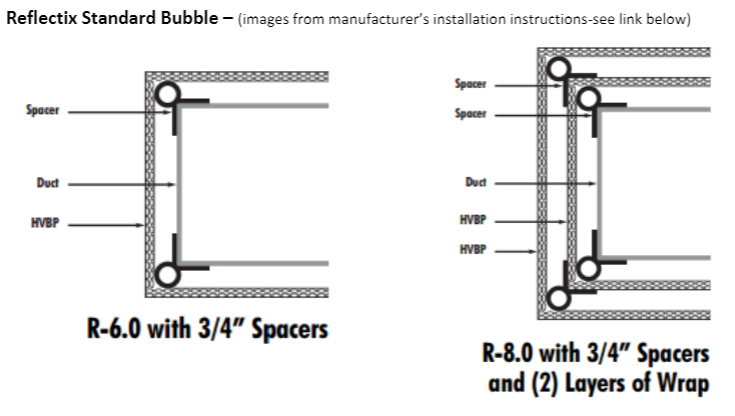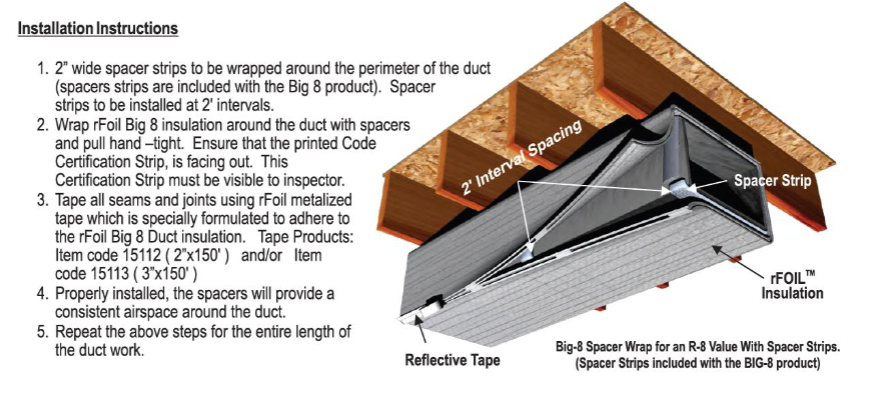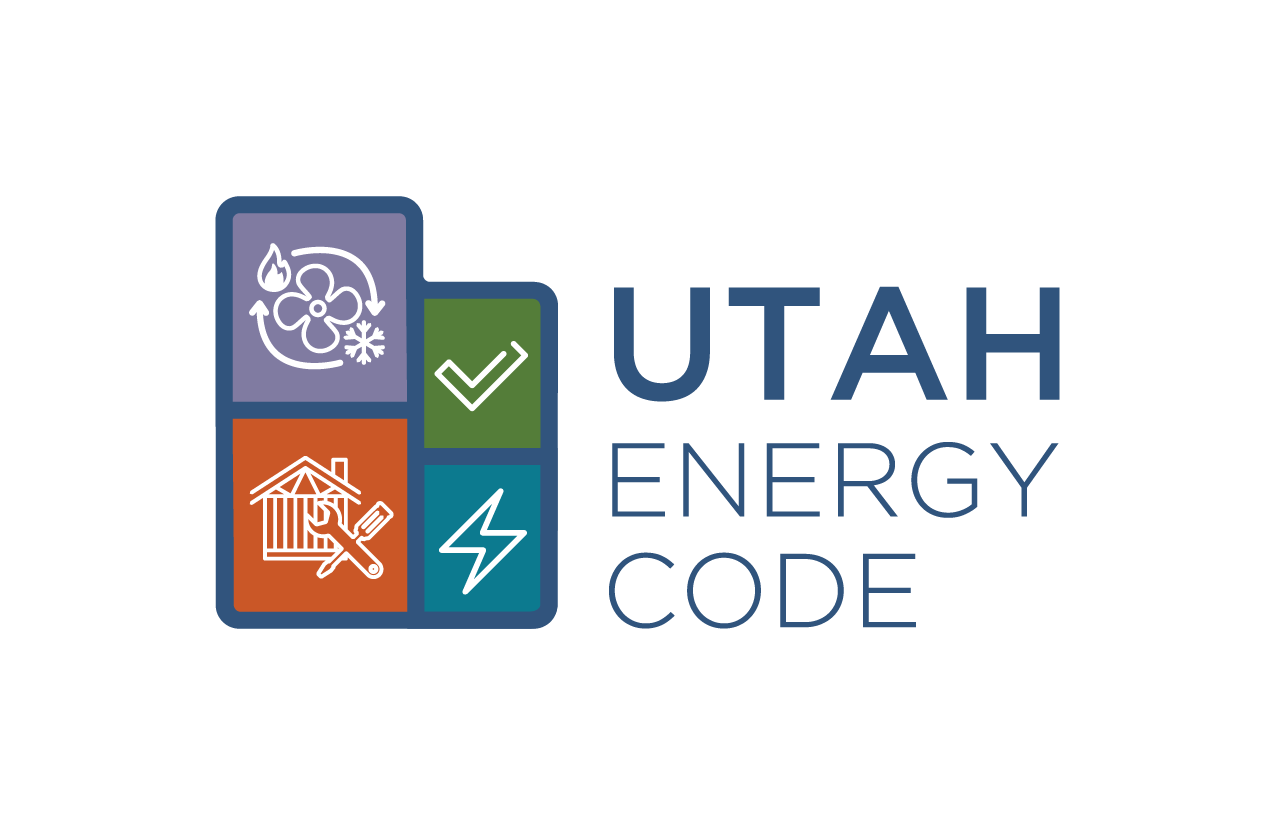
FOIL-FACED BUBBLE WRAP DUCT “INSULATION”
As we continue to see ‘foil bubble insulation’ used incorrectly as duct insulation, it is time to separate the facts from the fiction. This is a critical issue as the improper installation of these products often increases the heat loss or gain by a factor of four, creating a compounding effect on the building HVAC systems and energy consumption. Where duct insulation fails to meet the R-values assumed in building construction and load calculations, system sizing will be incorrect, comfort suffers, energy consumption increases, and system longevity decreases.
The International Mechanical Code (IMC) and the International Residential Code (IRC) reference the International Energy Conservation Code (IECC), for the R-value requirements for duct insulation. The IECC, as currently adopted in Utah specifies the following:
2015 IECC/IRC RESIDENTIAL DUCT INSULATION MINIMUM REQUIRED R-VALUE:
-
-
- Outside or in ventilated attics 3” diameter or greater: R-8
- Less than 3” diameter: R-6
- In crawlspace or other unconditioned spaces, 3” diameter or greater: R-6
- Less than 3” diameter: R-4.2
- Outside or in ventilated attics 3” diameter or greater: R-8
-
2018 IECC COMMERCIAL DUCT INSULATION MINIMUM REQUIRED R-VALUE:
-
-
- Outside including ventilated attics:
- Climate Zones 1-4: R-8
- Climate Zones 5-8: R-12
- Enclosed unconditioned spaces:
- All Climate Zones: R-6
- Outside including ventilated attics:
-
Going back at least 25 years, several manufacturers of foil bubble type materials have incorrectly claimed R-values significantly higher than actual values. Following actions by the FTC, including fines, manufacturers of these products are generally now producing published installation instructions which must be followed to achieve claimed compliant R-values. Additionally, manufacturers are producing products which can in some cases meet the required IECC R-values.
The FACTS:
-
-
- A layer of 1/4” to 3/8” single layer foil bubble insulation has an approximate maximum R-value of 1.1, not 4 or 5.
- That single layer, installed with a completely sealed ¾” air space, might produce an R-value of R-4 to R-6.
- Two layers of 1/4” foil bubble insulation, correctly installed with two sealed air spaces may, depending on the manufacturer, attain an R-8 insulative value.
- Two layers of 1/4” foil bubble insulation, the second directly on top of the first without sealed air spaces, produce an approximate effective R-2.2, nothing near R-6 or R-8. This is a quite common misapplication.
- Claims of “effective R-value” based on the reflective nature of the product are immaterial, as the code requires actual R-value. R-values must be supported by industry standards and/or testing.
- Any increased R-value due to air spaces, requires an air space on the reflective side of the material. Bubble foil under a slab obviously has no air space on the shiny/bottom side. Consider the R-value of the product only, when applied under slab.
- Many manufacturers and distributors have published claims that blur the line between product R-values and assembly R- values.
- Fortunately, most manufacturers have removed the incorrect claims from their websites; however, beware of vague claims such as “higher R-values” or “resists the transfer of heat”.
- Claims of R-4, R-6 and R-8 when used as a duct wrap typically require providing air spaces between layers of the product with specific spacers. Spacers as specified by the manufacturer and must be used to create required airspaces. All seams must be taped and sealed, using specific required materials, ensuring the airspaces are tightly enclosed. IF the air spaces are NOT sealed, allowing outside or attic temperature air into the airspace, the R-value is Zero.
- Several manufacturers claim R-4 if a single layer is ‘loosely wrapped’ around the duct; however, there is no technical testing or engineering calculations supporting this claim. Loosely wrapped is not a defined term in any applicable standards or code.
- Please be aware of the R-12 requirement for commercial building duct systems. I am not aware of any R-12 claims for reflective duct ‘insulation’ products.
- To date, I am aware of only two products which have submitted their products to the ICC or other evaluation services organizations and received an ES Evaluation Report: EcoFoil/rFoil and Both products may be used as duct insulation ONLY when installed with spacers, exactly as specified in the reports and the manufacturer’s installation instructions. The attached diagrams are taken directly from ICC-ES Evaluation reports or manufacturer’s installation instructions. Foil bubble insulation that is NOT installed in accordance with report or installation requirements is not code compliant and must not be approved.
- Manufacturers are now producing 2-layer foil bubble insulation products with factory manufactured spacers and an airspace within a roll of the product. Please be aware that even with these products, an additional airspace must be field created between the duct and the foil bubble material to obtain a R-8 R-value. Refer to the examples below, from Evaluation Reports and Manufacturer’s Installation Instructions.
- A layer of 1/4” to 3/8” single layer foil bubble insulation has an approximate maximum R-value of 1.1, not 4 or 5.
-
The first two diagrams detail installations of typical 1/4” to 3/8” thick products requiring two sealed air spaces. The third image/installation instruction is for a product manufactured with two layers and spaces laminated together creating one of the air spaces.

rFoil Big 8 2 (images from manufacturer’s installation instructions- see link below)

In summary, foil bubble insulation materials have been and continue to be installed incorrectly over the past 25+ years, resulting in the negative impacts previously discussed. Manufacturers, distributors, contractors, and building inspectors are not serving the best interest of homeowners, commercial building owners, and occupants when these products are improperly installed. If you choose to use these products, evaluation reports and installation instructions should be submitted at the time of permit application, followed by an installation in full compliance with all specifications and installation requirements. Where an inspector or builder observes the use of these products, please request manufacturers’ installation instructions, and verify full compliance with those documents, with a critical focus on sealed air spaces.
For further information on rFoil products see:
https://www.icc-es.org/wp-content/uploads/report-directory/ESR-1236.pdf
For further information on Reflectix products see:
https://www.reflectixinc.com/products/double-reflective-insulation/
Feel free to use the Contact Us link if you have comments or questions on this or any other energy code issues.
– Dr. Energy

0 Comments